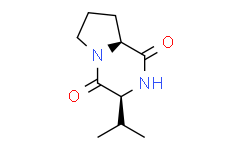| Cas No.: | 2854-40-2 |
| Chemical Name: | Pyrrolo[1,2-a]pyrazine-1,4-dione,hexahydro-3-(1-methylethyl)-, (3S,8aS)- |
| Synonyms: | Pyrrolo[1,2-a]pyrazine-1,4-dione,hexahydro-3-(1-methylethyl)-, (3S,8aS)-;(3S,8aS)-3-propan-2-yl-2,3,6,7,8,8a-hexahydropyrrolo[1,2-a]pyrazine-1,4-dione;Cyclo(-Pro-Val);(3S,8aS)-3-Isopropylhexahydropyrrolo[1,2-a]pyrazine-1,4-dione;cyclo(-L-pro-L-val-);cyclo-(L-Val-L-Pro) |
| SMILES: | CC([C@H]1C(N2CCC[C@H]2C(N1)=O)=O)C |
| Formula: | C10N2O2H16 |
| M.Wt: | 196.2462 |
| Purity: | >98% |
| Sotrage: | 2 years -20°C Powder, 2 weeks 4°C in DMSO, 6 months -80°C in DMSO |
| Description: | Cyclo(L-Pro-L-Val) is a diketopiperazine that has been found in the marine sponge T. ignis, the bacterium B. pumilus, and the fungus A. fumigatus, among others.It is active against the bacteria S. aureus and B. subtilis (MICs = 16.3 and 18.2 µg/ml, respectively) but not E. coli (MIC = >20 µg/ml).Cyclo(L-Pro-L-Val) inhibits activation of a LuxR-dependent E. coli biosensor by the quorum-sensing molecule 3-oxo-hexanoyl-homoserine lactone (IC50 = 0.4 mM) and activates violacein pigment production in the LuxR-dependent C. violaceum acyl homoserine lactone reporter strain CV026.However, it does not activate or inhibit lacZ-based reporter fusions in S. liquefaciens or A. tumefaciens. |

 DC Chemicals' products qualify for U.S. tariff exemptions. We guarantee no price increases due to customs duties and maintain stable supply, continuing to deliver reliable research solutions to our American clients.
DC Chemicals' products qualify for U.S. tariff exemptions. We guarantee no price increases due to customs duties and maintain stable supply, continuing to deliver reliable research solutions to our American clients.





















